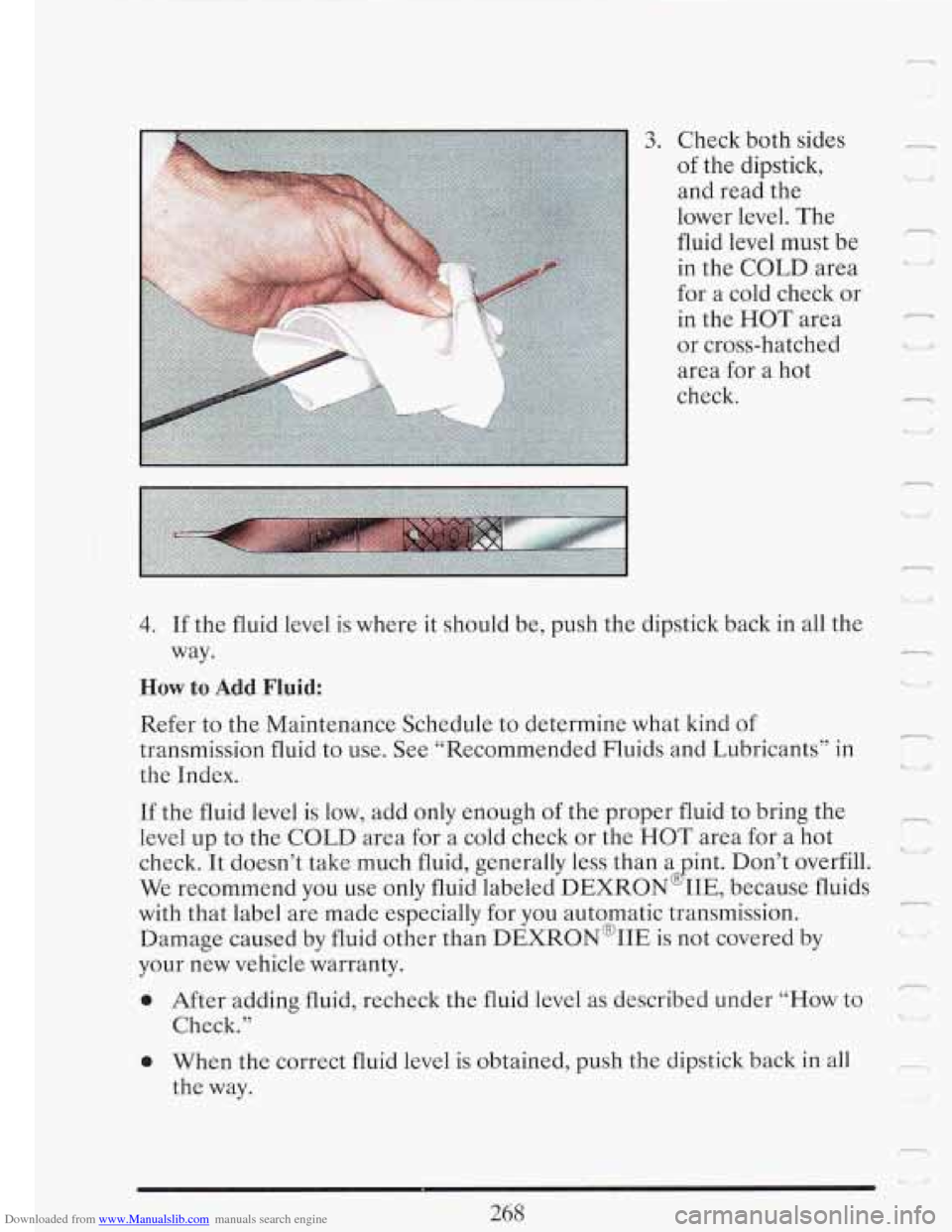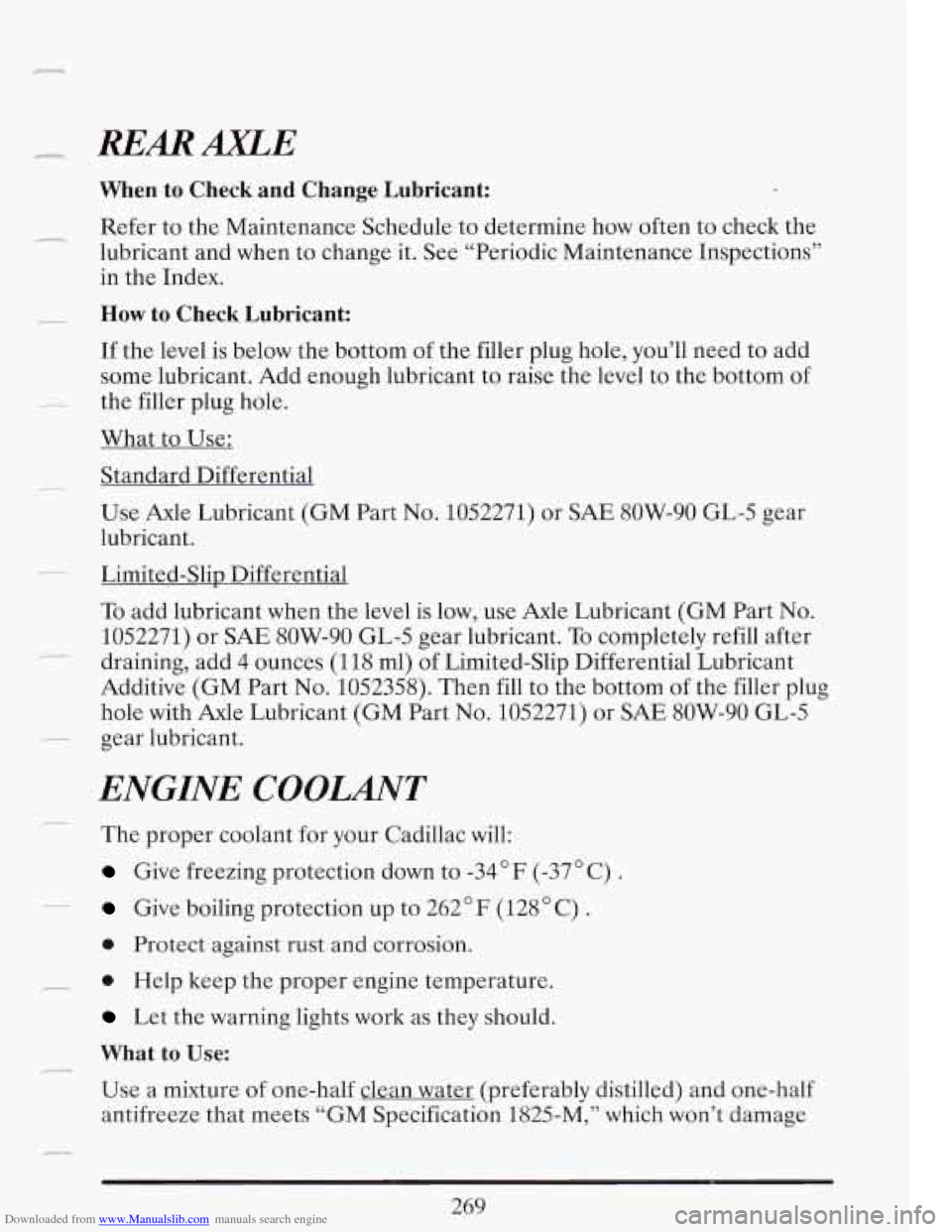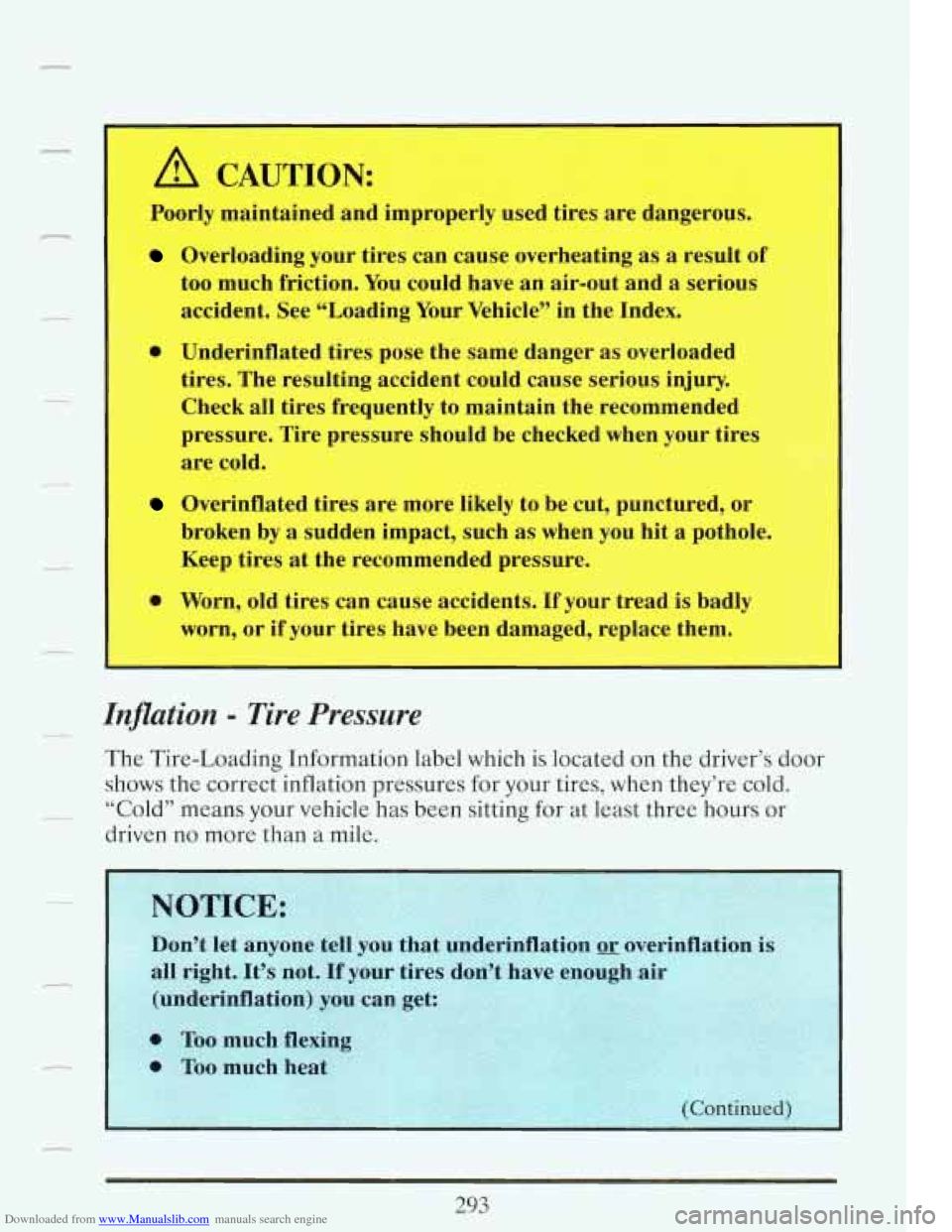Page 281 of 386
Downloaded from www.Manualslib.com manuals search engine n To check transmission fluid cold: A cold check is made afte.r the vehicle
has been sitting for eight hours or more with the engine off and is used
only as a reference. Let the engine run at idle for five minutes if outside
temperatures are
50°F (10°C) or more. If it’s colder than 50°F (lO°C),
you may have to idle the engine longer. A hot check must follow when
fluid is added during a cold check. .-
To check the fluid hot or cold:
0 Park your vehicle on a level place.
Place the shift lever in “P” (Park) with the parking brake applied.
__
With your foot on the brake pedal, move the shift lever through each
gear range, pausing for about three seconds in each range. Then,
position the shift lever in
“P” (Park). ~
0 Let the engine run at idle for three minutes or more.
Then. without shutting
off the engine! follow these skgs:
2. Push it back in all the way, wait three seconds and then pull it back out
again.
267
Page 282 of 386

Downloaded from www.Manualslib.com manuals search engine 3. Check both sides
of the dipstick,
and read the
lower level. The
fluid level must be
in the COLD area
for a cold check or
in the HOT area
or cross-hatched area for a hot
check.
r
i4
I’
n i; U
4. If the fluid level is where it should be, push the dipstick back in all the
way.
How to Add Fluid:
Refer to the Maintenance Schedule to determine what kind of
transmission fluid to use. See “Recommended Fluids and Lubricants” in
the Index.
If the fluid level is low, add only enough of the proper fluid to bring the
level
up to the COLD area for a cold check or the HOT area for a hot
check. It doesn’t take much fluid, generally less than a
int. Don’t overfill.
We recommend you use only fluid labeled
DEXRON IIE, because fluids
with that label are made especially for you automatic transmission.
Damage caused
by fluid other than DEXRON@IIE is not covered by
your new vehicle warranty.
8
0 After adding fluid, recheck the fluid level as described under “How to
Check.”
0 When the correct fluid level is obtained, push the dipstick back in all
the way.
n I L> Y
r
Ll
I
r.
- I ‘1
Page 283 of 386

Downloaded from www.Manualslib.com manuals search engine r REARAXLE
1
When to Check and Change Lubricant:
Refer to the Maintenance Schedule to determine how often to check the
lubricant and when to change it. See “Periodic Maintenance Inspections”
in the Index.
How to Check Lubricant:
If the level is below the bottom of the filler plug hole, you’ll need to add
some lubricant. Add enough lubricant to raise the level to the bottom of
What to Use:
~ the filler plug hole.
Standard Differential
Use Axle Lubricant (GM Part
No. 1052271) or SAE 8OW-90 GL-5 gear
lubricant.
Limited-Slip Differential
To add lubricant when the level is low, use Axle Lubricant (GM Part No.
1052271) or SAE 8OW-90 GL-5 gear lubricant. To completely refill after
draining, add
4 ounces (1 18 ml) of Limited-Slip Differential Lubricant
Additive (GM Part
No. 1052358). Then fill to the bottom of the filler plug
hole with Axle Lubricant (GM Part
No. 1052271) or SAE 8OW-90 GL-5
~ gear lubricant.
ENGINE COOLANT
The proper coolant for your Cadillac will:
Give freezing protection down to -34°F (-37’ C) .
_- Give boiling protection up to 262°F (128°C) .
0 Protect against rust and corrosion.
__ 0 Help keep the proper engine temperature.
Let the warning lights work as they should.
What to Use:
Use a mixture of one-half clean water (preferably distilled) and one-half
antifreeze that meets
“GM Specification 1825-M,” which won’t damage
269
Page 285 of 386
Downloaded from www.Manualslib.com manuals search engine _q Adding Coolant
To Check Coolant:
When your engine is
cold, the coolant level
should be at “ADD,”
or a little higher.
When your engine is
warm, the
level should
be up to
“FULL,” or a
little higher.
To Add Coolant: If you need more coolant, add the proper mix at the
coolant recoverv tank. -.
Turning the radiator pressure cap when the engine and radiator
are hot can allow steam and scalding liquids to blow out and
burn you badly. With the coolant recovery tank, you will almost
never have to add coolant at the radiator. Never turn the
radiator pressure cap
-- even a little -- when the engine and
radiator are hot.
I
~
Add coolant mix at the recovery tank, but be careful not to spill it.
I A CAUTION:
You can be burned if you spill coolant on hot engine parts.
Coolant contains ethylene glycol, and it will burn if the engine
parts are enough. Don’t spill coolant on a hot engine.
’
Page 287 of 386
Downloaded from www.Manualslib.com manuals search engine - How To Check Power Steering Fluid:
Unscrew the cap and wipe the dipstick with a clean rag. Replace the cap
and completely tighten it. Then remove the cap again and look at the
_q fluid level on the dipstick.
0
0 When the engine
compartment is
hot, the level
should be at the
“HOT” mark.
When the engine
compartment is
cool, the level
should be at the
“FULL COLD”
mark.
- What to Add:
Refer to the Maintenance Schedule to determine what kind of fluid to
- use. See “Recommended Fluids and Lubricants” in the Index.
273
Page 290 of 386
Downloaded from www.Manualslib.com manuals search engine -
L.. i
Refer to the Maintenance Schedule to determine when to check your
brake fluid. See “Periodic Maintenance Inspections” in the Index.
To Check Brake Fluid:
I
You can check the brake fluid without taking off the cap. Just look at the
windows on the brake fluid reservoir. The fluid levels should be above
“MIN.” If they aren’t, have your brake system checked to see if there is a %
leak.
7-
After work is done on the brake hydraulic system, make sure the levels
are above “MIN” and below the top
of each window.
What to Add:
When you do need brake fluid, use only DOT-3 brake fluid -- such as
Delco Supreme
11 @ (GM Part No. 1052535). Use new brake fluid from a
sealed container only.
276
L1
Page 307 of 386

Downloaded from www.Manualslib.com manuals search engine A CAUTION:
i --
Poorly maintained and improperly used tires are dangerous.
Overloading your tires can cause overheating as a result of
I
too much friction. You could have an air-out and a serious
accident. See “”Loading Your Vehicle” in the Index.
0 Underinflated tires pose the same danger as overloaded
tires. The resulting accident could cause serious injury.
Check all tires frequently
to maintain the recommended
pressure. Tire pressure should
be checked when your tires
are cold.
I
I Overinflated tires are more likely to be cut, punctured, or
broken by
a sudden impact, such as when you hit a pothole.
Keep tires at the recornmended pressure.
@ Worn, old tires can cause accidents. If your tread is badly
worn, or if your tires have been damaged, replace them.
Inflation - Tire Pressure _c
The Tire-Loading Information label which is located on the driver’s door
shows the correct inflation pressures
for your tires, when they’re cold.
driven no more than a mile.
- “Cold’’ means your vehicle has been sitting for at least three hours or
293
Page 308 of 386
Downloaded from www.Manualslib.com manuals search engine ea
When to Check Check your tires once a month or more.
Don't forget your compact spare tire. It should be at
60 psi (420 kPa).
How to Check Use a good quality pocket-type gage to check tire
pressure. Simply looking at the tires
will not tell you the pressure,
especially
if you have radial tires -- which may look properly inflated even
if they're underinflated.
If your tires have valve caps, be sure to put them back on. They help
prevent leaks by keeping out dirt and moisture.
Your tire pressures are:
Front and rear - 30 psi (210 kPa)
Optional Limousine packages:
Front and rear - 35 psi (241 kPa)
Recommended tire size is:
0 P235/70R15 (Front and rear)
0 T145/80D 16 (Compact spare)
0 P235/75R15 XL (Coach Builder Option) d
n
'd I
294